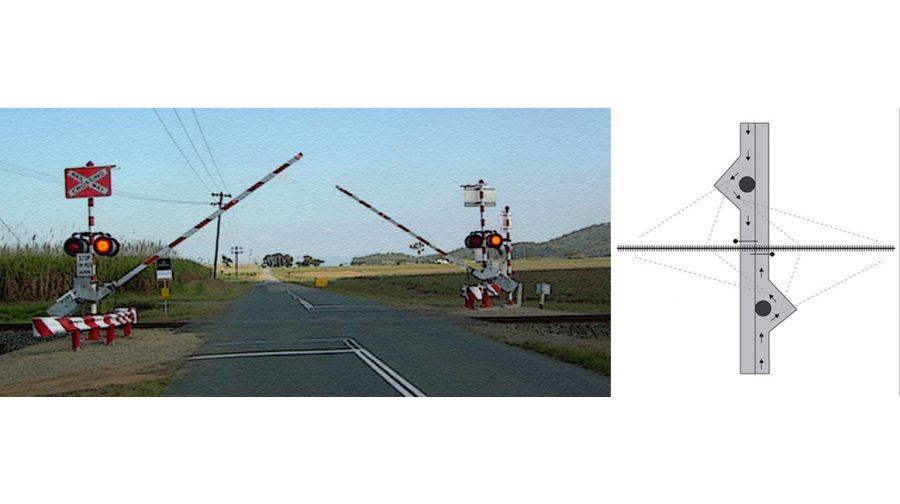
By Muthiah Kasi, PE, SE, CVS-Life, FSAVE
When faced with different solutions for the same need, a FAST diagram can be developed to breakdown the thinking behind the solution. This helps to select the appropriate solution that fits with the stakeholders needs, desires and constraints.
Two types of railroad crossings were analyzed and the FAST diagrams was drawn to help with the comparison.
The following conversation illustrates the critical thinking behind the solutions.
 BEN: How was your overseas trip? Bring me back anything good?
BEN: How was your overseas trip? Bring me back anything good?
ASH: It was… interesting. And yes! Here’s a magnet. Don’t ever say I didn’t get you nothin’.
BEN: Thanks…. (immediately hands magnet to a passerby without Ash seeing it)
ASH: So other than having my wallet stolen, getting three flat tires, and being chased down by a rogue bull, it was great!
BEN: Sounds like a blast.
ASH: I thought about you when I was over there.
BEN: Thanks?
ASH: There was this railroad crossing that didn’t make any sense, much like you. Look at this. (Ash sketches it out for Ben) When you approach the crossing, your lane turns 30 degrees to the right and then turns 30 degrees to the left all the while avoiding a giant ditch four inches deep in the middle of the road. I found out it’s designed that way to force drivers to look left and right before going across the tracks, while slowing down or your car is going to need a new under carriage. Pretty crazy right?
BEN: Well, there are two ways we learn to practice strategic thinking.
ASH: How did I know you were going to try and make this reasonable?
BEN: I didn’t say that. I’m just saying there might be logic in the madness. You can go from planning to the solution, or the solution to planning. And this made me think what the objectives were to warrant this design say compared to what the objects are here in the U.S.
ASH: Hm. Alright. Well, I would say that our crossings are designed based on volunteerism and over there it seems to be designed based on restriction or forced activity and also trying to total one car at a time.
BEN: I’m sure that’s not what they intended. But I agree that the objectives are way different. Here we promote safety, while over there it seems like they want to enforce safety. The opposing objectives makes for different solutions.
ASH: They’re going for the same thing right? Why the different views?
BEN: If you wanted to break it down, we would need to identify the functions and objectives. To do that we need to figure out the people behind the functions and objectives. The people who have an interest is on the line are called the stakeholders. This can be an owner, users, or other interested parties. In this case the owner would be the agency who is responsible for safe crossings.
ASH: Ok. So if they are the owner, then the user would be the motorists clearly.
BEN: Not quite. You need to be more specific when thinking about this.
ASH: Motorists…. and cyclists?
BEN: (sigh) No. The needs and constraints of users may differ. So for this railroad crossing, the list for the owners would make up of the trains coming from the left and the trains coming from the right. The list for the users would be the motorists who obey the law and the motorists who ignore the law.
ASH: Ok, the motorists who obey the laws, and the motorists who ignore them; they make up two different user groups? So are those two groups responsible for two opposing objectives?
BEN: Bingo. Now you’re getting it Ash!
ASH: Wait, you mentioned another type of stakeholder, that wasn’t an owner or a user? A third party?
BEN: Interested party, so yeah, basically a third party who is interested. So take this four inch ditch they put right in the middle of the road, here in the U.S. lawyers would have a field day with this. If someone were injured there would be lawsuits left and right. And because of the lawyers, this forced solution design they have over there would not fly over here. They would be the other stakeholder, the interested party. Plus our drivers don’t fit the same profile as the drivers over there so there is no need for such a drastic designs.
ASH: So the lawyers are helping with the function Minimize Liability?
BEN: Yes! Imagine that. Lawyers doing good for a change. Let’s look at it like this. If you take the two objectives, promoting safety and forcing attention; promoting safety initiates actions like figuring out the size we need for warning signs, the location of those signs, flashing lights and the levels of the warning sounds. It is also dependent upon the user, how the drivers pay attention to the signage and if they obey them. This would fall under the umbrella of the function Educate Users. If the users do not honor the objective then we take the kid gloves off and change the objective to Force Attention. With Force attention, the activities would be stopping conditions, turning roadways and creating large holes in the ground to total your car. No more Mr. nice guy.
ASH: Wow. Let’s hope that it never gets that bad over here.
BEN: I think we should be safe for extreme measures like that.
ASH: As simple as it is, people impact what this country does. All our minuscule actions can reflect the character of our country, right down to our driving habits.
BEN: Crazy to think about right?


